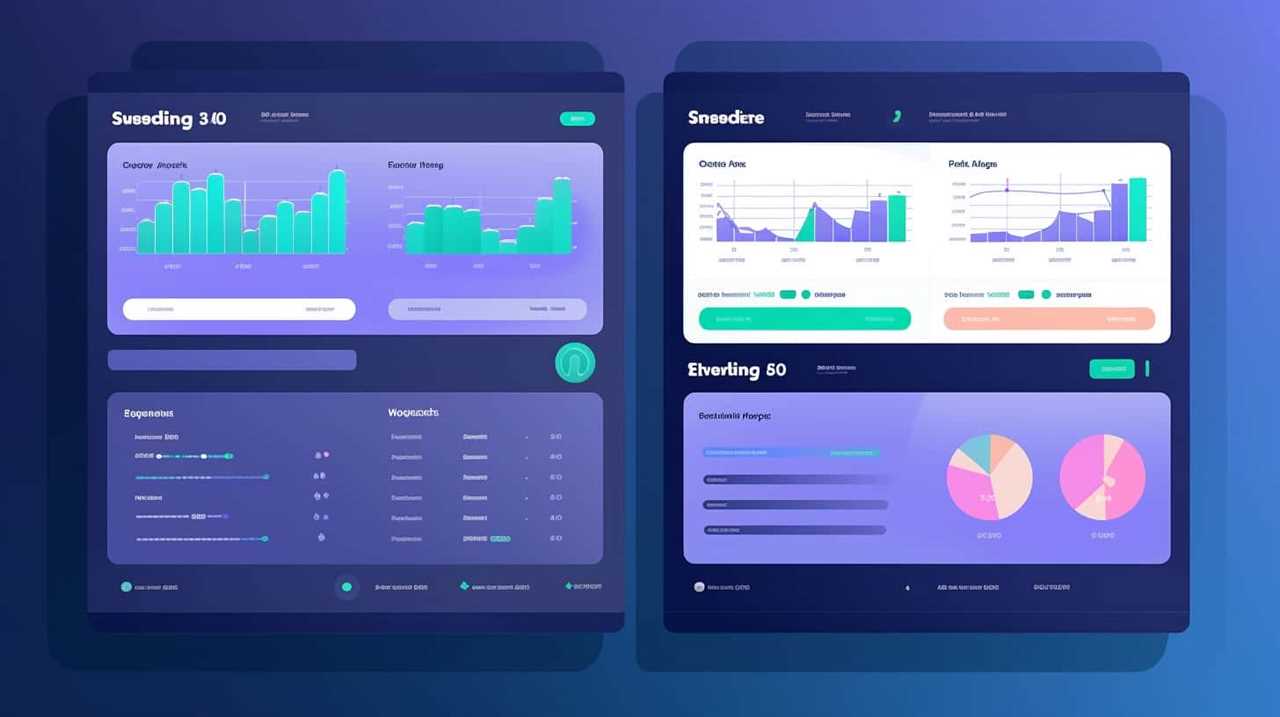Are you prepared to elevate your digital marketing initiatives to the next stage?
Look no further than Google Ads for Personal Trainers! With the power of Google Ads, we can shape up your online presence and reach your ideal audience.
It’s like having a personal trainer for your marketing strategy, guiding you every step of the way.
From creating effective ad campaigns to maximizing your online visibility, Google Ads is the key to mastering your online marketing game.

Let’s get started and see the results!
Key Takeaways
- Google Ads allows personal trainers to reach a large and targeted audience, tapping into the vast user base of Google.
- Personal trainers can measure the return on investment (ROI) of their advertising efforts and gain valuable insights into ad performance through Google Ads.
- Targeting the right audience is crucial for personal trainers to maximize their advertising budget and increase the likelihood of converting potential customers into clients.
- Ad testing, optimization techniques, keyword research, and ad copy and design are important strategies for personal trainers to maximize their online visibility and attract more potential clients.
The Benefits of Google Ads for Personal Trainers
One of the key benefits of using Google Ads for personal trainers is the ability to reach a large and targeted audience. Compared to social media ads, Google Ads offer a wider reach and the potential to connect with individuals actively searching for fitness services. While social media ads can be effective for brand awareness and engagement, Google Ads allow personal trainers to tap into the vast user base of the search engine giant.
Moreover, Google Ads provide the opportunity for personal trainers to measure the return on investment (ROI) of their advertising efforts. With the right tracking tools and analytics, trainers can gain valuable insights into the performance of their ads, such as the number of clicks, impressions, and conversions. This data-driven approach enables trainers to make data-backed decisions to optimize their campaigns and ensure that their marketing budget is well spent.
Understanding Google Ads and how to leverage their power is crucial for personal trainers looking to make a significant impact in the digital realm. In the next section, we’ll dive into a beginner’s guide to Google Ads, where we’ll explore the fundamental concepts and strategies to help trainers navigate this powerful advertising platform successfully.

Understanding Google Ads: A Beginner’s Guide
So you’ve decided to explore the world of Google Ads for your personal training business, but where do you start? Understanding Google Ads may seem overwhelming at first, but it doesn’t have to be.
In this beginner’s guide, we’ll break down the benefits of Google Ads and how you can effectively target your audience to maximize your online marketing efforts.
Let’s dive in and shape up your online advertising strategy!
Benefits of Google Ads
To understand the benefits of Google Ads, we’ll explore how this advertising platform can help personal trainers enhance their online marketing efforts.

Google Ads offers a range of advantages that can greatly benefit personal trainers in improving their reach and increasing conversions. Consider the following benefits:
- Greater Visibility: With Google Ads, personal trainers can reach a wider audience by appearing at the top of search engine results, increasing their chances of being seen by potential clients.
- Targeted Advertising: Google Ads allows personal trainers to target specific keywords and demographics, ensuring their ads are shown to the right audience who are more likely to convert into clients.
By utilizing Google Ads, personal trainers can maximize their online marketing efforts and effectively reach their target audience.
Now, let’s dive into the next section and discuss how to better target this audience.
Targeting Your Audience
In targeting our audience through Google Ads, we can further enhance our online marketing efforts as personal trainers. By utilizing customer segmentation and ad personalization, we can tailor our advertisements to specific groups of people who are more likely to be interested in our services. This targeted approach allows us to maximize our advertising budget and increase the likelihood of converting potential customers into actual clients.

To better understand the power of customer segmentation and ad personalization, let’s take a look at the following table:
| Customer Segment | Ad Personalization |
|---|---|
| Young professionals | Offer time-efficient workouts for busy schedules |
| Stay-at-home parents | Highlight family-friendly fitness options |
| Seniors | Emphasize low-impact exercises for joint health |
As you can see, by customizing our ads to meet the unique needs and desires of different customer segments, we can increase the effectiveness of our marketing campaigns.
Now that we understand the importance of targeting our audience with Google Ads, let’s explore how we can specifically target our ideal audience for even greater success.
Targeting Your Ideal Audience With Google Ads
When it comes to running successful Google Ads campaigns as personal trainers, one of the most important aspects is targeting the right audience.

By identifying the demographics of your target customers, you can refine your ad targeting to reach those who are most likely to be interested in your services.
This not only increases the chances of converting leads into clients but also maximizes your return on investment by ensuring that your ads are seen by the right people.
Identifying Customer Demographics
By targeting our ideal audience with Google Ads, we can effectively identify customer demographics for personal trainers. With customer segmentation and demographic analysis, we can gain valuable insights into the characteristics and preferences of our target audience.
Here’s how we can paint a picture of our audience:

- Age: Understanding the age range of our customers helps us tailor our marketing messages and services accordingly. Are we targeting millennials looking for quick workout routines or middle-aged individuals seeking long-term fitness solutions?
- Location: Knowing where our customers are located allows us to focus our marketing efforts in specific areas. Are we targeting urban dwellers who prefer convenience or suburban residents who prioritize community-oriented fitness centers?
Identifying customer demographics through Google Ads enables us to create personalized campaigns that resonate with our ideal audience, ultimately leading to increased engagement and conversions.
Refining Ad Targeting
To further refine our ad targeting and reach our ideal audience with Google Ads, we can utilize specific criteria to tailor our campaigns to their needs and preferences.
One effective way to optimize our ads is through ad testing. By creating multiple variations of our ads and testing them against each other, we can gather valuable data on which ad performs best. This allows us to make data-driven decisions and allocate our budget towards the most effective ads.
Additionally, we can optimize our ads by utilizing ad optimization techniques. This involves constantly monitoring and adjusting our ads based on their performance metrics, such as click-through rates and conversion rates.

Creating Effective Ad Campaigns for Personal Trainers
We shape effective ad campaigns for personal trainers using Google Ads. When it comes to creating ad campaigns, optimization is key. Here are some strategies we employ to ensure your ads are reaching the right audience and generating the results you desire:
- Keyword research: We conduct thorough research to identify the most relevant and high-performing keywords for your personal training business. This helps us optimize your ad campaign and increase its visibility to potential clients.
- Ad copy and design: Our team of experts crafts compelling ad copy that highlights the unique benefits of your personal training services. We also create visually appealing designs that grab attention and encourage clicks.
By implementing these strategies, we can help you maximize the effectiveness of your ad campaigns and attract more clients to your personal training business.
However, creating effective ad campaigns is just the first step. To truly dominate the online market, you need to maximize your online visibility with Google Ads. In the next section, we’ll explore how to achieve this and take your online marketing efforts to the next level.
Maximizing Your Online Visibility With Google Ads
Now, let’s delve into how we can further enhance your online visibility using Google Ads. When it comes to maximizing your online presence, it’s important to make the most out of your ad spend and optimize your keywords.

By carefully managing your budget and targeting the right keywords, you can ensure that your ads are seen by the right audience at the right time.
To maximize your ad spend, it’s crucial to constantly monitor and analyze your campaign performance. By regularly reviewing your data, you can identify which keywords are driving the most traffic and conversions, allowing you to allocate your budget effectively. Additionally, you can identify any underperforming keywords and make adjustments to improve their performance.
Optimizing your keywords is another key factor in maximizing your online visibility. By conducting thorough keyword research and targeting relevant and specific keywords, you can increase the chances of your ads appearing in relevant search results. It’s important to regularly review and update your keywords to stay ahead of the competition and ensure that your ads are reaching the right audience.
By maximizing your ad spend and optimizing your keywords, you can significantly enhance your online visibility and attract more potential clients. However, it’s equally important to track and analyze your Google Ads performance to continuously improve your strategy.

In the next section, we’ll discuss how you can effectively track and analyze your Google Ads performance to ensure the success of your online marketing efforts.
Tracking and Analyzing Your Google Ads Performance
When tracking and analyzing our Google Ads performance, we can gain valuable insights into the effectiveness of our online marketing efforts. By monitoring and evaluating the data, we can make informed decisions to optimize our campaigns and achieve better results.
Here are some key points to consider when tracking performance and analyzing data:
- Conversion tracking: Setting up conversion tracking allows us to measure the actions taken by users after clicking on our ads. We can track website visits, form submissions, phone calls, and other valuable actions that indicate a potential customer’s interest or engagement.
- Keyword performance: Analyzing the performance of our selected keywords helps us understand which ones are driving the most clicks, conversions, and ultimately, revenue. By identifying high-performing keywords, we can allocate our budget more effectively and adjust our bidding strategies accordingly.
- Ad performance: Evaluating the effectiveness of our ads is crucial for optimizing their performance. We can analyze click-through rates (CTRs), conversion rates, and other metrics to identify which ads resonate best with our target audience. This data can guide us in creating more compelling and engaging ad copy that drives better results.
- Audience insights: Tracking and analyzing data about our audience allows us to understand their preferences, behaviors, and demographics. This information helps us tailor our ad campaigns and messaging to better reach and resonate with our target market.
Frequently Asked Questions
How Much Does It Cost to Advertise on Google Ads as a Personal Trainer?
When it comes to advertising on Google Ads as personal trainers, we need to consider cost analysis and effective strategies. It’s important to understand how much it costs to reach our target audience and maximize our online marketing efforts.

Are There Any Specific Regulations or Guidelines for Personal Trainers When Advertising on Google Ads?
Advertising restrictions and best practices for personal trainers on Google Ads include adhering to guidelines for accuracy, avoiding misleading claims, and promoting responsible fitness practices. It’s essential to create engaging ads that resonate with potential clients and showcase your expertise.
Can Google Ads Help Personal Trainers Reach Potential Clients Outside of Their Local Area?
Google Ads for Personal Trainers: Shaping Up Your Online Marketing can help us expand our client base by reaching potential clients outside of our local area. We can maximize our ROI with effective targeting strategies.
Is It Possible to Track the Number of Leads or Conversions Generated Through Google Ads for Personal Trainers?
Tracking leads and conversions through Google Ads for personal trainers is crucial in maximizing ROI. With the ability to measure and analyze data, we can make informed decisions to shape our online marketing strategy and reach our goals.
Are There Any Alternatives to Google Ads That Personal Trainers Can Consider for Their Online Marketing Efforts?
There are several alternative platforms that personal trainers can consider for their online marketing efforts. When comparing their effectiveness to Google Ads, it’s important to evaluate factors like target audience, budget, and desired outcomes.

Conclusion
In conclusion, Google Ads is an invaluable tool for personal trainers looking to boost their online marketing efforts. By understanding how to effectively target their ideal audience and create compelling ad campaigns, trainers can maximize their online visibility and attract more clients.
With the ability to track and analyze their ad performance, trainers can continuously optimize their strategies for even greater success. Google Ads truly is the key to shaping up your online marketing and taking your personal training business to new heights.
It’s like having a personal marketing assistant on steroids!










